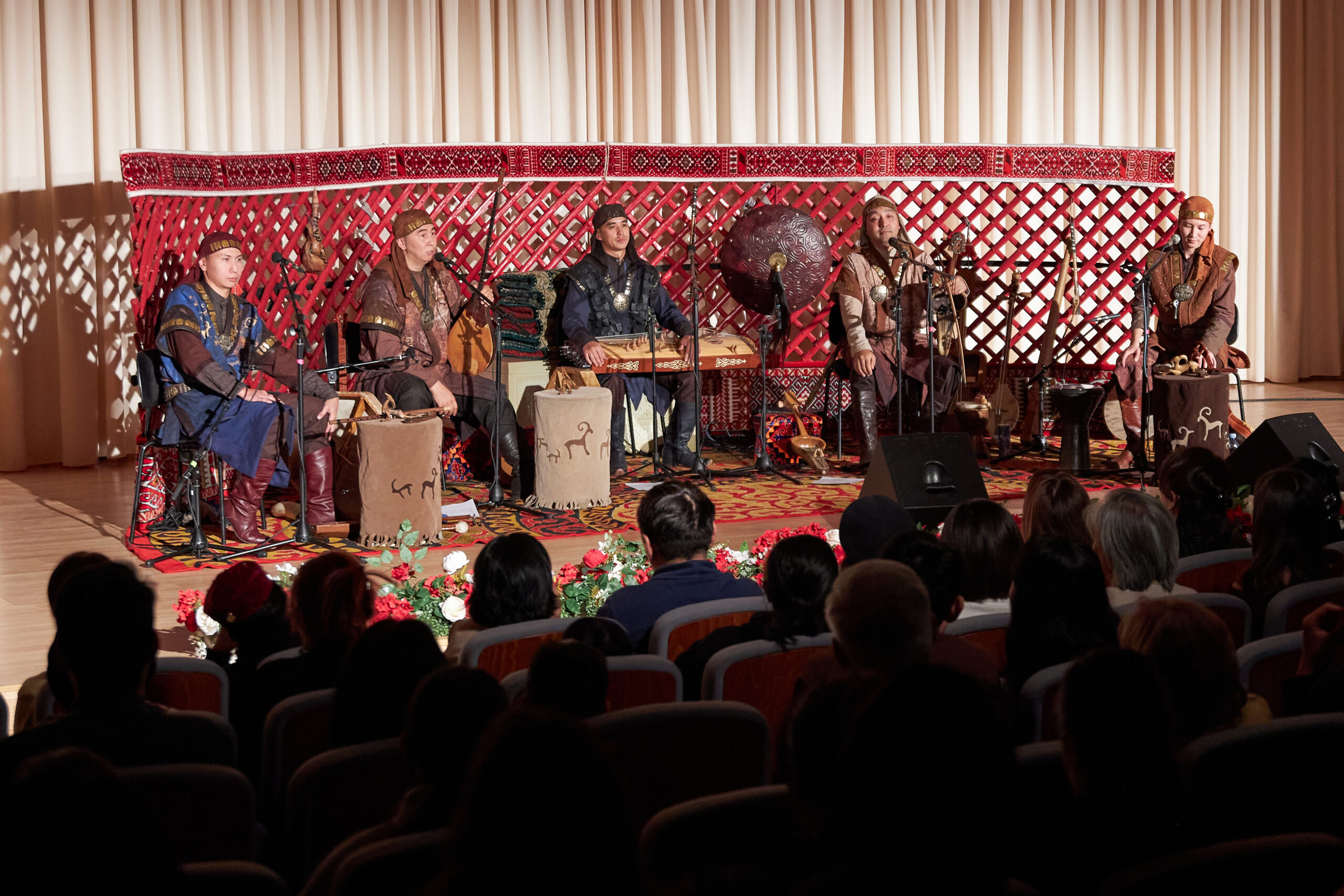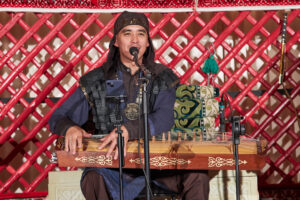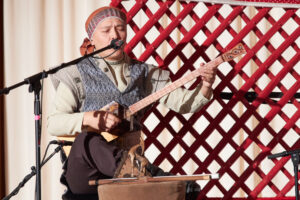ASTANA – Last weekend, Kazakhstan’s Turan ethno-folk ensemble took the stage of the Qazaq Concert to perform a traditional music set, showcasing the variety and richness of Kazakh and Turkic nations’ instruments in Astana.

Kazakh ethno group Turan returned to Astana with a lecture-concert. Photo credit: Arman Eshmanov/Qazaq Concert
After wowing foreign audiences in 2023 with a world tour, Kazakh ethno group Turan returned to Astana with a lecture-concert. Established in 2008, the ensemble has given more than 3,000 concerts in 122 cities of the world. The group has performed in such famous halls as Carnegie Hall in New York, Kennedy Center in Washington, Konzerthaus in Berlin, Palais des Congrès et Festivals in Cannes, and Salle Cortot in Paris.
Turan ensemble aims to celebrate the diversity of Kazakh and Turkic national instruments by bringing them into the international scene. They perform on over 40 instruments to show the depth of traditional Kazakh and Turkic music, offer unmissable vocal and instrumental experiences, and have viewers leave the concerts inspired to carry on this message of unity among the brotherly nations.

Turan ensemble member Erzhigit Aliyev performing on zhetigen, Kazakh national instrument. Photo credit: Arman Eshmanov/Qazaq Concert
It is this kind of cosmopolitan mix that has made Turan a hit with both local and foreign audiences.
“The specialty of our concert, as the name suggests, is that it’s a lecture event where we tell the history of each instrument, how we use these instruments in our creativity, and it is also a chance for us to connect with the audience directly,” said the ensemble member Erzhigit Aliyev in an interview with The Astana Times.
“We also talk about the healing properties of these instruments, about their special magical powers, and we touch on the topics of baksy (shamans) because most of our national instruments, such as dangyra, kobyz, are the instruments that come from baksy times,” he added.
Along with well-known Kazakh instruments such as dombra, kobyz and zhetigen, the concert highlighted other Turkic nations’ instruments, including the Kyrgyz komuz, Turkish baglama and Azerbaijani kamancha.
The variety of sounds can astonish even the most discerning ear. If you think all kobyz music sounds the same, prepare to be blown away by the variety of voices on show: from the sound of wind blowing to the calls of a swan or an eagle – so vivid, one would think it is soaring right above you.
Gratitude from fans – an exchange that goes both ways
The ensemble pours their entire energy into the performance. That exchange goes both ways, as they are met with tears and heartfelt gratitude from the audience.

Gratitude from fans is an exchange that goes both ways. Photo credit: Arman Eshmanov/Qazaq Concert
Traditional music found new roots among listeners eager to reconnect with their identity and awaken the hidden emotions within their hearts. Aliyev shared one of the most memorable exchanges with such a fan.
“When we were in the United States, after our performance, as we took our bow on stage, I noticed a man in the audience crying. Later, while we were in the dressing room, that same elderly man came in, still with tears in his eyes, and thanked us. He said, ‘You are so fortunate—you have your own national instruments, your inner code, which awakens your spirit and emotions.’ Being a multi-instrumentalist himself, he shared that he was still searching for his own musical identity. He hugged me and expressed his gratitude, saying that although he had been searching for himself through various instruments, he had yet to find one that truly resonated with his heart,” said Aliyev.
The latest addition to the repertoire – Tamyr album
Last year, Turan released an album titled Tamyr (Root). Tamyr I Part album is a great introduction to the rich musical world of Turkic nations, including Kazakh, Kyrgyz, Azerbaijan, Turkish, Turkmen, Yakut, Macar, Altay and Karakalpak music and instruments.

The ensemble member Serik Nurmolda playing on dombra. Photo credit: Arman Eshmanov/Qazaq Concert
The ensemble member Serik Nurmolda said the Tamyr project carries three meanings.
“First of all, tamyr is the root of a tree. Just as a tree cannot grow without its roots, which provide essential nourishment, this serves as an allegory for human life, suggesting that everyone needs to be connected to their roots. The strength and growth of a tree depend on how deep its roots go, just as a person’s flourishing depends on understanding and drawing sustenance from their heritage,” said Nurmolda.
He further explained the second meaning behind Tamyr through a Kazakh saying: “62 roots (channels) have softened,” meaning a state of complete bodily relaxation and well-being.
“In the human body, if these 62 channels are absent, no organ—whether it’s the liver or the heart—can function. These root channels connect the organs, and along with blood supplying oxygen, they are the source of the body’s energy. That’s why we say the 62 roots must be whole and complete,” he said.
Through music, Turan tries to foster a sense of togetherness and unity among all Turkic nations. “In an allegorical sense, it means that even though we are scattered, the Turkic states, our roots should be united. Only in that way, when we are together, it will work well and fully,” he added.
The third symbolic meaning of Tamyr comes from another interpretation of the word, where tamyr means “my friend, my companion” or “my brother.”
“So, when I tell my Kyrgyz and Uzbek brothers that you are my roots, they immediately understand,” said Nurmolda. The album is like a narrative that translates traditional music into the internationally understandable language of music.
Upcoming parts of the album
According to Nurmolda, the music they are preparing for the Tamyr is not limited to one album. In the upcoming parts of the Tamyr series, prepare to be immersed in a selection of music from other Turkic nations and from minority nations. The final, fourth piece will feature works by contemporary composers.
Nurmolda explained that their main criteria for an album was that it contains each nation’s music that is truthful and close to the hearts of the listeners.
“Every nation has faced hardships throughout history. For example, when we speak about the difficult times endured by the Kazakh people, the Turkic people are moved to tears. If you ask why, they’ll say, ‘The same happened to us.’ Just as Kazakhs weep when singing the song ‘Elim-ay’ (Oh, my land), Azerbaijanis do the same with ‘Ay, Lacin.’ That’s why we wanted to take these deeply emotional songs and compositions from the hearts of people, give them our musical arrangement and then to show that our roots are one,” said Nurmolda.


